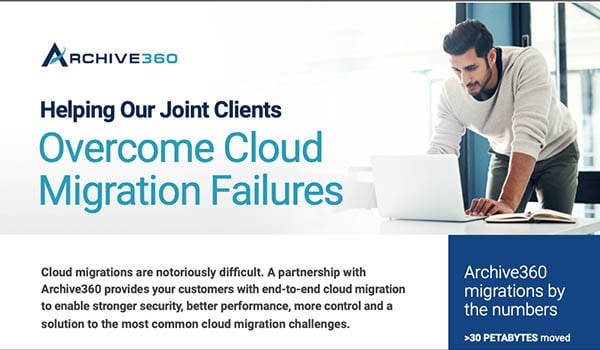Email Archive Migration for OpenText AXS-One Archive
Move away from your aging, legacy email archive and embrace the true power of the secure cloud archive trusted by organizations worldwide.

Table of Contents
- Take Back Control of Your Data and Boost Your Business in the Cloud
- Option 1: The SaaS Archiving Solution
- Option 2: Migrating to Your Own Public Cloud
- SaaS vs. Open Archive
- Enjoy a Fast, Accurate, and Seamless OpenText AXS-One Archive Migration
- Common Questions When Moving Away from OpenText AXS-Once Archive
Is Your Aging Email Archive Limiting Your Business?
The OpenText AXS-One Archive was once all you needed for collecting, archiving and reviewing your Microsoft Exchange and Lotus Notes emails, facilitating eDiscovery, and maintaining compliance with regulations like Sarbanes-Oxley (SOX), the Health Insurance Portability and Accountability Act (HIPAA), the Federal Rules of Civil Procedure (FRCP), the Freedom of Information Act 2000 (FOIA), the Financial Industry Regulatory Authority (FINRA) and the Securities and Exchange Commission Rules (SEC Rule 17a-4 & Rule 17a-3). However, as regulatory requirements and the demands of modern business have changed, legacy archiving software, such as OpenText AXS-One Archive, Enterprise Vault, and GWAVA Retain, haven’t kept pace with the times, forcing their developers and customers to create risky workarounds or, in the case of MX Logic and Mimosa NearPoint, drop support altogether. The time has come to look for alternatives, and, as is the case for many, corporate digital transformation initiatives (such as the adoption of cloud-based tools like Microsoft Office 365 and Gmail) make cloud-based archiving a much more attractive prospect. Migrating your OpenText AXS-One archive to the cloud provides a way to not only handle all of your historical archiving needs but to unlock many new opportunities for your business, as well as provide flexibility and scalability as your requirements shift and your organization grows.
Take Back Control of Your Data and Boost Your Business in the Cloud
The OpenText AXS-One Archive was once all you needed for collecting, archiving and reviewing your Microsoft Exchange and Lotus Notes emails, facilitating eDiscovery, and maintaining compliance with regulations like Sarbanes-Oxley (SOX), the Health Insurance Portability and Accountability Act (HIPAA), the Federal Rules of Civil Procedure (FRCP), the Freedom of Information Act 2000 (FOIA), the Financial Industry Regulatory Authority (FINRA) and the Securities and Exchange Commission Rules (SEC Rule 17a-4 & Rule 17a-3).
 However, as regulatory requirements and the demands of modern business have changed, legacy archiving software, such as OpenText AXS-One Archive, Enterprise Vault, and GWAVA Retain, haven’t kept pace with the times, forcing their developers and customers to create risky workarounds or, in the case of MX Logic and Mimosa NearPoint, drop support altogether.
However, as regulatory requirements and the demands of modern business have changed, legacy archiving software, such as OpenText AXS-One Archive, Enterprise Vault, and GWAVA Retain, haven’t kept pace with the times, forcing their developers and customers to create risky workarounds or, in the case of MX Logic and Mimosa NearPoint, drop support altogether.
The time has come to look for alternatives, and, as is the case for many, corporate digital transformation initiatives (such as the adoption of cloud-based tools like Microsoft Office 365 and Gmail) make cloud-based archiving a much more attractive prospect.
Migrating from an on-premises archive to the cloud provides a way to not only handle all of your historical archiving needs but to unlock many new opportunities for your business, as well as providing flexibility and scalability as your requirements shift and your organization grows.
Understanding the Difference Between the Real Cloud and a SaaS ‘Kind of’ Cloud
When it comes to migrating your legacy archives to the cloud, two main options exist. The first is to choose a Software as a Service (SaaS) solution, like those offered by Mimecast and Smarsh. While solutions of this kind might seem like the simple way to go, they do come at the cost of security, access, accountability, and control over your data. The second and far superior option is to migrate to your own public cloud tenant, where you can experience all the benefits of the cloud without compromising control or limiting your security options. Let’s take a look at these two options in more detail…
Option 1: The SaaS Archiving Solution
You’ll likely hear SaaS vendors claim that they offer the best turn-key cloud archiving platforms. While it’s true that your data will be stored in the cloud, that’s where the similarities to true cloud archiving end. It’s a fact that most SaaS vendors don’t own their own datacenters, opting instead to rent part of a public cloud and store all of their customers’ data within it. This is what’s known as a multi-tenant cloud, and it provides a significant drawback for the client – your encryption keys are controlled by the SaaS vendor and could be used across their other clients. Because these encryption keys could be re-used among many clients, data breaches and the associated regulatory issues are much greater. This also means that the SaaS vendor can access your company’s sensitive data at any time.
 This fact alone is a major security red flag for CISOs, but there are additional downsides to the SaaS model when it comes to security. Due to the multi-tenant, one-size-fits-all approach, moving to a SaaS archive means giving up control of a lot of things. You can’t set security policies specific to your business as they’re dictated by the vendor. Everything from the firewall in use to the vetting of third parties is controlled by your SaaS provider, reducing your security accountability and forcing you to make exceptions for one element of your IT footprint.
This fact alone is a major security red flag for CISOs, but there are additional downsides to the SaaS model when it comes to security. Due to the multi-tenant, one-size-fits-all approach, moving to a SaaS archive means giving up control of a lot of things. You can’t set security policies specific to your business as they’re dictated by the vendor. Everything from the firewall in use to the vetting of third parties is controlled by your SaaS provider, reducing your security accountability and forcing you to make exceptions for one element of your IT footprint.
Additionally, by moving your data to a SaaS archive, you also lose control over what you do with it. With many SaaS vendors storing your files in their proprietary format, your data is stored in what amounts to a data prison, with huge charges incurred if you ever want to move your data out of their SaaS cloud platform. In addition to this data ransoming, you are also unable to make use of cutting-edge solutions, such as powerful data analytics capabilities or ML (Machine Learning) and AI (Artificial Intelligence) technology to provide content-based auto-classification for accurate information management.
Ultimately, when it comes to content archiving, SaaS solutions create many negatives, especially regarding security and flexibility, and offer minimal advantages by comparison to the various hyperscale cloud offerings.
Some of the SaaS Archiving Challenges:
- No access to encryption keys
- Little to no control over security policies
- Limited search options for audio, video, and other non-email files
- Proprietary formats limit your ability to move your data
- Little or no control over your data’s geographic location – data sovereignty
- Data analysis and eDiscovery functionality is limited to “lowest common denominator” vendor-provided tools
In a recent survey of global IT executives, including VPs, directors, and members of the C-suite at major corporations, only 19% of those surveyed believed 75% or more of their SaaS vendors met all of their security requirements. 70% stated they had been forced to make at least one security exception for a SaaS vendor. While many of these organizations are likely using popular SaaS products like Microsoft Office 365 and SalesForce (where the size and standing of the vendor might make the business more amenable to accepting a perceived lower risk) the clear takeaway is that third-party SaaS solutions don’t provide the security standards modern organizations require.
 Elsewhere, on the topic of encryption keys, an astounding 95% of respondents believed it was important to control their own encryption keys, and 81% were uncomfortable with their SaaS vendors controlling them. However, 74% of those surveyed said they did not control the encryption keys for the majority of their SaaS solutions.
Elsewhere, on the topic of encryption keys, an astounding 95% of respondents believed it was important to control their own encryption keys, and 81% were uncomfortable with their SaaS vendors controlling them. However, 74% of those surveyed said they did not control the encryption keys for the majority of their SaaS solutions.
These are worrying statistics and ones that many organizations will have to take steps to reverse as regulations continue to tighten and the threat of cybercrime grows. To that end, 92% of executives said they would need more security customization in the future, with 63% of them planning to retire SaaS applications that didn’t provide them control over encryption keys.
These statistics paint a clear picture of the business security landscape and the risk that the one-size-fits-all approach of SaaS vendors introduces. As the trend for security customization continues and scrutiny over data access and handling increases, SaaS solutions will become increasingly less palatable for businesses aiming to de-risk their operations. Instead, more secure and customizable solutions, such as those in the public cloud, will be sought.
Option 2: Migrating to Your Own Public Cloud
The only way to ensure you retain complete control over your sensitive, archived data and can apply your own security standards and protocols, is to migrate to an archive hosted in your own secure hyperscale cloud. Archives hosted in public clouds, like those from Microsoft and Amazon, can provide you with full flexibility, unlimited access to your data, data storage in its native format, and the most advanced security features and controls. In a hyperscale cloud-based archive, you can also make use of cloud-scale AI and ML to unlock crucial business insight from your data, as well as focused and accurate supervision, predictive surveillance, and e-discovery searches. None of this is possible with a SaaS archive, making a clear distinction between an archive hosted in a true public cloud that you control, and one hosted in the ‘kinda’ cloud’ offered via SaaS.
A public cloud archive should provide you with...
- Immediate access to your data in its native format
- Full control of where data is stored for data sovereignty
- The ability to granularly search content within audio, video and social media files
- Flexibility and on-demand scalability – use only what you need
- Reduced upfront investment and predictable ongoing costs
- No need for legacy infrastructure and ongoing maintenance fees
- Faster, scalable eDiscovery searches and customizable regulatory controls
- Access to the latest AI and ML technology for data classification, mining, and analysis
- Complete control over security, compliance, and privacy
SaaS vs. Open Archive
| Features | SaaS Archives | Open Archive |
| Infrastructure | ||
| Host data in your corporate cloud | ||
| Security | ||
| Protect Data with encryption keys | ||
| Compliance | ||
| Meet SEC 17a-4 regulations | ||
| Meet GDPR Regulations | Limited | |
| Policy-driven records | Limited | |
| Compliant onboarding | ||
| Performance | ||
| Active user-based pricing | ||
| Management | ||
| Standard eDiscovery with case management | ||
| AI-powered eDiscovery | ||
| Manage any content/data type | Limited | |
| Records analysis, classification and management | Limited | |
| Policy-driven records classification and transformation | ||
| Data Loss Prevention and sensitive data analysis alerts | ||
| Export and produce data for third party consumption | ||
| Role-based access with Active Directory Integration | Limited | |
| Native import and export with O365, SharePoint Online and OneDrive | Limited | |
| Onboarding | ||
| Accelerated onboarding at 50 TB per day | ||
| Restore legacy archives back to native format | ||
| Pricing | ||
| Active user-based pricing | ||
| Interactive Users - free of charge (restrictions apply) |
Enjoy a Fast, Accurate, and Seamless OpenText AXS-One Archive Migration
When you begin considering how to move the terabytes of data in your legacy archive to the cloud, one of your first steps should be to decide on a migration partner. While a number of migration vendors exist, including QuadroTech and Transvault, we believe that the key is a high-performance email migration tool that can not only move your data to the cloud at the highest possible speed but ensure the migration is complete, accurate, and that chain of custody is maintained.
Offering both archive migration and secure archiving in your own cloud, Archive360 provides you with a single point of contact throughout your journey, ensuring you understand what is being migrated and how it will be done, while limiting the impact on your network bandwidth and end-user productivity. We can help you analyze your existing data, organize and account for email that has been stubbed, determine whether archiving or journaling is the right decision going forward, and migrate your existing legacy data to a cloud-based solution like Office 365, all within your own public cloud tenant.
Archive Migration
Our combination of experience and cloud-based automation is going to make you look really good.
- Complete chain-of-custody and exception reporting down to the item level
- Advanced features for managing your stubs to ensure your end-users experience zero disruption
- Unique approach to handling journal archives your legal and compliance teams will appreciate
- Many destination options including Office 365 and dozens of other cloud-based and on-premises archives
Open Archiving
We interviewed 1,100 customers to learn what they loved and hated about their legacy archive and used that insight to create a completely new kind of archive platform.
- More secure: If you don't control your encryption keys, you don't control your data. With our archive, only you have access to your encryption keys.
- More private: Privacy laws require you to retain data in the region it was created. SaaS archives don't do that. Our archive automatically stores employee and customer data in the country of origin.
- More insight: Your archive holds incredible insight that until now has been trapped in a black box. Our archive empowers you to extract intelligence from your emails, files and videos for the first time.
Common Questions When Moving Away from OpenText AXS-Once Archive
With more than a thousand successful archive migrations completed, Archive360 knows a thing or two about the migration process. Our years of experience enable us to dispel your fears and answer any questions you might have as you begin your journey to the cloud. Such questions might include...
- How much data do I actually have in my archive and what kind of data is it?
- How much “dark data” do I have (such as archived messages from inactive users and leavers)?
- Do I need to migrate the entire archive and/or the journal archive?
- What happens to messages that have been stubbed?
- I have ongoing or pending litigation; can I still migrate my mail?
- Will I be able to account for 100% of my archived mail?
- How long will the migration take?
- How do I manage archived email that is under legal hold? What special handling is needed to maintain chain of custody?

Learn More
Archive360 Email Migration Software Product Highlights
Archive360 offers the most trusted email archive migration solution available, specifically designed for the OpenText AXS-One Archive. Fully integrated with the archive’s APIs for faster, more accurate extractions, Archive360 extracts messages and attachments, including all metadata, directly from the AXS-One archive and maintains an item-level audit trail for compliance and legal reporting. It also preserves complete, original message fidelity for eDiscovery and regulatory information requests.
Archive360’s OpenText AXS-One Archive Migration Detail
- Utilizes a multi-threaded, multi-server architecture
Provides the highest performance and accuracy of all migration solutions - Uses native AXS-One Archive Web APIs
Enables search and filtering of emails by custodian, date range, and other criteria - Intuitive and powerful graphical user interface
Less time needed for training – faster time to migration - Message level chain of custody reporting
Legally defensible reporting reduces eDiscovery risk - Does not require indexing or data gathering before extraction
Begin message extraction within minutes of installation unlike other solutions that take days or weeks to index before project start
The Cloud Archive Organizations Trust
Archive360 provides the cloud archive trusted by enterprises and government agencies worldwide, purpose-built to run in the hyperscale cloud. Installed and run from your organization’s individual public cloud, you retain all the power, flexibility, and management while maintaining complete control of your data and its security, including encryption keys that only you have access to. Additionally, unlike on-premises and SaaS archiving solutions, you are free to unlock valuable insights via data analytics and carry out powerful searches on your data using the latest cloud-based tools that will benefit multiple teams across your business, from HR to legal and compliance.
Archive Migration Connectors
Archive360 has successfully helped more than 2,000 customers extract data from 20+ enterprise archives, legacy applications, and file system repositories, including the following:
(click on the link for more information)
- ArchiveOne C2C
- Autonomy EAS
- Autonomy NearPoint
- Autonomy Consolidated Archive
- EMC EmailXtender
- EMC SourceOne
- Gwava Retain
- Dell EMS MessageOne
- Dell Quest Archive Manager
- HPCA
- Opentext AXS-One
(Exchange and IBM Notes) - Opentext Email Archive
(Exchange and IBM Notes) - Opentext IXOS
(Exchange and IBM Notes) - Commvault Simpana
- Zovy Archive
- Metalogix
- PSTs
- IBM NSFs
.png)


